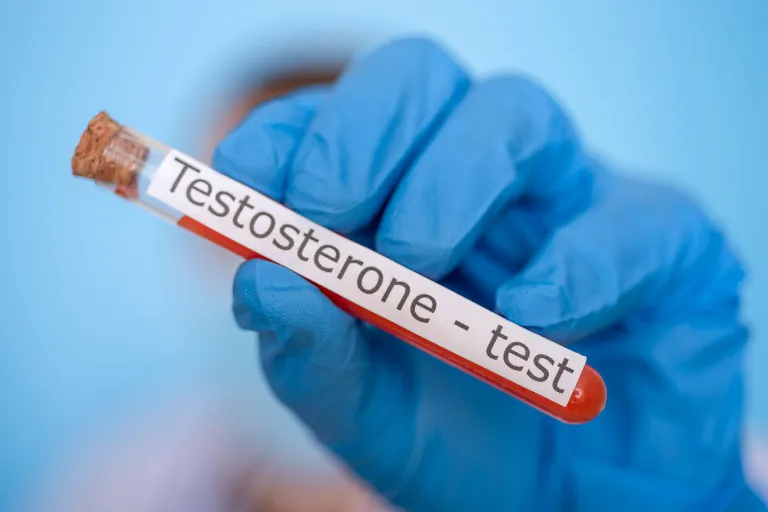Wichtige Punkte
- Testosterone plays a critical role in energy, mood, libido, muscle mass, and overall vitality.
- Low levels can lead to symptoms like fatigue, low sex drive, weight gain, and mental fog.
- Different test types—total, free, and bioavailable—serve different diagnostic needs.
- Blood testing is the most accurate method, but at-home kits offer convenience.
- Interpreting results often requires looking beyond testosterone to other hormone levels.
Is Your Testosterone Holding You Back?
Persistent fatigue, loss of motivation, changes in sex drive—these symptoms are often brushed off as normal parts of aging or stress. But for many men, they may be signaling a deeper issue: low testosterone. According to a longitudinal study published in The Journal of Clinical Endocrinology & Metabolism, up to 24% of men over age 30 may experience declining testosterone levels that affect quality of life—yet most go undiagnosed and untreated (Harman et al., 2001).
Testosterone testing isn’t just for bodybuilders or men in midlife crisis. It’s a practical tool to assess your hormonal health, understand changes in your body, and take proactive steps if something’s off.
Why Testosterone Testing Matters
Testosterone influences far more than sex drive. It’s a key hormone involved in maintaining muscle mass, bone strength, energy levels, and mental clarity. It also plays a role in mood regulation and metabolic function. When levels are too low, men can experience a cascade of symptoms—often subtle at first—that include tiredness, low motivation, irritability, diminished libido, or even depressive states. Over time, low testosterone is also linked to increased risks for blood sugar regulation problems, cardiovascular issues, and loss of bone density (Mayo-Klinik; Wu et al., 2010).
By identifying imbalances early, testosterone testing provides a valuable entry point for personalized solutions—whether that’s lifestyle changes, medical therapy, or targeted follow-up testing.
What Affects Testosterone Levels?
Testosterone naturally declines with age—typically by about 1% per year after age 30—but that’s only part of the story. Testosterone also follows a daily rhythm, with levels peaking in the early morning (between 7–10 a.m.) and gradually declining throughout the day. That’s why timing matters when testing.
Beyond age and timing, lifestyle factors play a significant role. Poor sleep, high stress, lack of physical activity, and excess body fat can suppress testosterone production. Excessive alcohol intake, drug use, and certain medications like opioids and corticosteroids are also known to reduce levels. On the medical side, chronic symptoms like inflammatory gut issues, hormonal signaling problems (e.g., low LH or FSH), or testicular injury can contribute to low testosterone (Endocrine Society, 2018).
Understanding these contributing factors is essential for accurate diagnosis and meaningful solutions.
Types of Testosterone Tests: What They Measure
Not all testosterone tests are created equal. Here’s what you need to know about the main types:
- Total Testosterone measures the overall amount of testosterone in your bloodstream, including both bound and unbound hormone. This is usually the first-line test.
- Free Testosterone focuses on the small portion of testosterone that is unbound and biologically active—what your body can actually use.
- Bioavailable Testosterone includes free testosterone plus the fraction loosely bound to albumin, offering a more nuanced view of what’s accessible to tissues.
If you’re experiencing symptoms but your total testosterone appears “normal,” your health professional may recommend additional testing for free or bioavailable levels (American Urological Association, 2018).
Testing Methods: Blood, Saliva, or At-Home Kits?
1. Blood Serum Testing
This is the gold standard. It’s typically done at a lab or clinic and allows for a full hormonal panel, including related markers like LH, FSH, and SHBG. Blood testing is recommended by most major medical organizations due to its accuracy and reliability.
2. Saliva Testing
Saliva tests are non-invasive but less reliable for testosterone due to variations in collection methods and lower hormone concentrations in saliva. These are more commonly used in research settings or for tracking cortisol.
3. At-Home Test Kits
At-home kits have gained popularity for their convenience and privacy. Most involve a simple finger-prick blood sample that’s mailed to a CLIA-certified lab. Commonly reviewed options include:
| Kit | Preis | Certification | Results Time | Features |
|---|---|---|---|---|
| Everlywell | $49–$199 | CLIA-certified | 5–7 days | Online dashboard, physician-reviewed |
| Lass uns überprüft werden | $89–$149 | CLIA-certified | 2-5 Tage | Includes virtual consultation |
| Verisana | ~$79 | Certified EU lab | 5–10 days | Multi-hormone test panels available |
| Cerascreen | ~$69 | Certified EU lab | 3-7 Tagen | Online access, lifestyle tips included |
While these kits are user-friendly, any abnormal result should be discussed with a qualified health professional for further evaluation and context.
What’s Considered a Normal Testosterone Level?
Normal total testosterone levels for adult men generally range from 300 to 1,000 ng/dL, according to the Endocrine Society. However, “normal” is not always ideal—some men may experience symptoms even at mid-range levels. That’s why interpreting results requires context.
In many cases, health professionals will also evaluate:
- SHBG (Sex Hormone Binding Globulin): Affects how much testosterone is available for use.
- LH (Luteinizing Hormone): Helps determine if the issue is with the testicles or the brain’s signaling.
- FSH (Follicle-Stimulating Hormone): Provides insight into reproductive function and sperm production.
This broader hormone profile helps identify the root cause of low testosterone and guides appropriate next steps.
If Your Testosterone Is Low, What Are Your Options?
Low testosterone doesn’t always require medication. Many men see improvement through lifestyle adjustments such as strength training, better sleep hygiene, stress reduction, and improved nutrition—especially diets rich in healthy fats, protein, and micronutrients like zinc and vitamin D.
If hormone therapy is appropriate, testosterone replacement therapy (TRT) may be prescribed in the form of injections, gels, or skin patches. These treatments can improve energy, mood, libido, and body composition—but they’re not one-size-fits-all and should only be used under careful medical supervision with routine monitoring (Endocrine Society Guidelines).
In some cases, “watchful waiting” with retesting after 3–6 months of lifestyle changes is recommended, especially when levels are borderline low but symptoms are mild.
Next Steps: Should You Get Tested?
If you’re feeling persistently tired, mentally foggy, unmotivated, or have noticed changes in your sex drive or physical performance, a testosterone test can provide important answers. Even if you’re not experiencing obvious symptoms, testing can help establish a baseline as you age.
You can start with an at-home kit or talk to a health professional about ordering a lab-based test. The key is to act on data—not guesswork. Early testing means more options and often simpler solutions.
Der Artikel stellt in keiner Weise eine medizinische Beratung dar. Bitte konsultieren Sie einen zugelassenen Arzt, bevor Sie eine Behandlung beginnen. Diese Website kann Provisionen für die in diesem Artikel erwähnten Links oder Produkte erhalten.
Quellen
- Harman, S. M., et al. (2001). Longitudinal Effects of Aging on Serum Testosterone Levels in Healthy Men. Journal of Clinical Endocrinology & Metabolism, 86(2), 724–731. Link
- Wu, F. C., et al. (2010). Identification of Late-Onset Hypogonadism in Middle-Aged and Elderly Men. New England Journal of Medicine, 363, 123–135. Link
- Mayo Clinic Staff. Testosterone Test. Mayo-Klinik. Link
- Endocrine Society (2018). Testosterone Therapy in Men with Hypogonadism: An Endocrine Society Clinical Practice Guideline. Link
- American Urological Association (2018). Evaluation and Management of Testosterone Deficiency: AUA Guideline. Link




